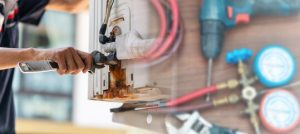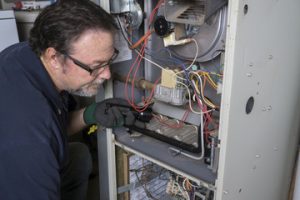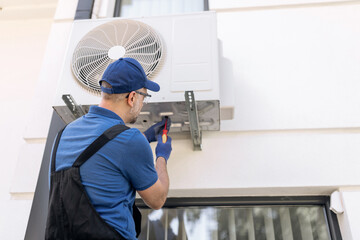HVAC Round Rock systems are essential for maintaining a comfortable and healthy indoor environment in both homes and businesses. Beyond controlling temperature, these systems regulate airflow, manage humidity, and filter airborne pollutants, all of which contribute to overall indoor air quality (IAQ). However, like any complex system, HVAC units require regular maintenance, timely repairs, and occasional upgrades to operate efficiently.
Reliable HVAC services not only restore proper system functionality but also enhance energy efficiency, extend equipment lifespan, and improve indoor air quality for year-round comfort. This guide explores the benefits of professional HVAC services, common system issues, preventive maintenance, and strategies to optimize indoor comfort and air quality.

The Importance of Reliable HVAC Services
HVAC systems are intricate assemblies of mechanical and electrical components, including compressors, coils, fans, ductwork, thermostats, and filters. When one component fails or operates inefficiently, it can affect the system’s performance, increase energy consumption, and compromise indoor comfort.
Reliable HVAC services ensure that all parts of the system function correctly and cohesively. Professionals provide comprehensive solutions, including installation, repair, maintenance, and system upgrades. Their expertise allows for accurate diagnostics, efficient repairs, and effective performance optimization.
For homeowners, reliable HVAC services translate into consistent temperatures, improved air quality, and reduced energy costs. In commercial settings, these services support employee productivity, maintain equipment longevity, and ensure a safe, comfortable environment for clients and staff.
Common HVAC Problems and How Experts Address Them
Understanding common HVAC problems helps property owners recognize when professional intervention is needed. Some typical issues include:
- Reduced Heating or Cooling Efficiency
- If certain areas of a property are too hot or cold, it may indicate airflow problems, thermostat malfunctions, or uneven duct distribution. HVAC professionals evaluate airflow, recalibrate thermostats, and repair system components to restore balanced temperatures throughout the space.
- Dirty or Clogged Filters
- Filters capture dust, pollen, and other pollutants, protecting the system and improving indoor air quality. Over time, filters become clogged, restricting airflow and reducing efficiency. Technicians inspect, clean, or replace filters to ensure optimal airflow and performance.
- Refrigerant Issues
- Air conditioning units rely on proper refrigerant levels to cool effectively. Leaks or insufficient refrigerant reduce cooling capacity and force compressors to work harder, increasing energy usage. Experts identify leaks, repair affected components, and recharge refrigerant to the correct levels.
- Electrical Problems
- Faulty wiring, blown fuses, or malfunctioning capacitors can disrupt HVAC operations or create safety hazards. Skilled technicians safely repair electrical components to restore system reliability.
- Unusual Noises or Odors
- Buzzing, rattling, or grinding sounds often signal mechanical or electrical issues, while musty or unpleasant odors may indicate mold or debris buildup. Professionals identify the source and perform necessary repairs, cleaning, or system adjustments.
- Water Leaks or Ice Formation
- Condensation leaks or ice buildup on coils indicate drainage or airflow problems. HVAC experts inspect and correct these issues to prevent further damage and maintain proper operation.
Timely repairs of these issues improve system efficiency, restore comfort, and prevent long-term damage that could require costly replacements.
The Role of Skilled HVAC Technicians
The effectiveness of HVAC services largely depends on the skills and experience of the technician. Reliable HVAC providers employ professionals trained to handle various systems, including central air units, ductless mini-splits, heat pumps, and commercial-grade equipment.
Technicians use advanced diagnostic tools to identify issues quickly and accurately. Their knowledge ensures that repairs are performed correctly the first time, minimizing recurring problems. Furthermore, professionals prioritize safety, handling electrical components and refrigerants according to industry standards to protect both property and occupants.
Benefits of Reliable HVAC Services
Investing in professional HVAC services provides numerous advantages for homeowners and business owners alike:
- Improved Energy Efficiency
- Well-maintained HVAC systems operate more efficiently, reducing energy consumption and lowering utility bills. Repairs such as fixing leaks, cleaning coils, and calibrating thermostats ensure optimal performance.
- Enhanced Indoor Air Quality
- Clean filters, proper ventilation, and humidity control help eliminate airborne contaminants, allergens, and pollutants, creating a healthier indoor environment.
- Consistent Comfort
- Reliable HVAC services restore even heating and cooling throughout the property, preventing hot or cold spots.
- Extended System Lifespan
- Professional maintenance and repairs reduce wear and tear, prolonging the life of the HVAC system.
- Cost Savings
- Timely repairs and preventive maintenance minimize the risk of emergency breakdowns and costly replacements.
- Safety and Compliance
- Professionals ensure electrical components, refrigerants, and ventilation systems are handled safely, protecting occupants and complying with safety regulations.
Preventive Maintenance for Year-Round Comfort
Regular maintenance is critical for maximizing system efficiency, preventing breakdowns, and maintaining air quality. Preventive HVAC maintenance typically includes:
- Filter Cleaning or Replacement
- Regular filter maintenance improves airflow, enhances indoor air quality, and prevents strain on system components.
- Coil Cleaning
- Evaporator and condenser coils accumulate dirt and debris over time, reducing efficiency. Cleaning these components ensures proper heat exchange and system performance.
- Refrigerant Level Checks
- Proper refrigerant levels maintain cooling efficiency and prevent compressor strain.
- Electrical Component Inspection
- Technicians check wiring, capacitors, and connections to prevent electrical failures and potential hazards.
- Ductwork Evaluation
- Sealing leaks, insulating ducts, and optimizing airflow improve efficiency and ensure even heating and cooling.
Many HVAC providers offer seasonal maintenance plans, scheduling inspections before peak heating or cooling periods. These services minimize unexpected repairs, maintain energy efficiency, and ensure consistent indoor comfort year-round.
Energy Efficiency Strategies
Energy efficiency is a key component of reliable HVAC service. Properly maintained and repaired systems consume less electricity while maintaining performance. Strategies to improve efficiency include:
- Repairing Leaks in Ducts or Refrigerant Lines
- Preventing leaks ensures energy is not wasted and systems operate at peak efficiency.
- Cleaning and Replacing Filters and Coils
- Improved airflow and heat exchange reduce energy consumption.
- Upgrading to High-Efficiency Components
- Modern compressors, fans, and motors use less energy while providing consistent performance.
- Thermostat Optimization
- Programmable or smart thermostats prevent unnecessary cycling, reducing energy costs without sacrificing comfort.
By implementing these strategies, property owners benefit from lower utility bills and a reduced environmental footprint.
Enhancing Indoor Air Quality
Indoor air quality is closely linked to HVAC system performance. Professionals help improve air quality through:
- High-Quality Filtration
- Advanced filters remove fine particles, allergens, and dust from the air.
- Humidity Control
- Properly balanced humidity reduces mold growth, allergens, and respiratory irritants.
- Air Purification Systems
- UV lights, ionizers, or HEPA filtration systems eliminate contaminants, enhancing indoor air quality.
These improvements not only support healthier living and working environments but also enhance the efficiency and longevity of the HVAC system.
Residential and Commercial Benefits
Residential Homes:
Reliable HVAC services provide homeowners with consistent indoor temperatures, improved air quality, and energy savings. Regular maintenance and timely repairs prevent sudden breakdowns and increase system longevity.
Commercial Spaces:
Businesses rely on efficient HVAC systems to maintain employee comfort, protect equipment, and enhance customer experiences. Professional services minimize downtime, reduce energy costs, and support safe and healthy environments for staff and clients.
Recognizing Signs You Need HVAC Services
Property owners should watch for indicators that HVAC maintenance or repair is required:
- Uneven indoor temperatures
- Strange noises or odors from the system
- Reduced airflow from vents
- Water leaks or ice buildup on components
- Frequent cycling of the system
- Unexpectedly high energy bills
Early recognition of these signs allows homeowners and businesses to schedule prompt service, preventing more serious problems and maintaining comfort and efficiency.
Choosing a Reliable HVAC Service Provider
When selecting an HVAC service provider, consider the following factors:
- Experience and Expertise
- Technicians should have experience with a variety of HVAC systems and brands to ensure accurate and effective repairs.
- Comprehensive Services
- Providers offering installation, repair, maintenance, and upgrades provide a complete solution for year-round indoor comfort.
- Response Time
- Fast and reliable service is crucial, especially during extreme temperatures.
- Quality Parts and Equipment
- High-quality replacement parts ensure long-lasting performance and system reliability.
- Preventive Maintenance Plans
- Scheduled maintenance reduces future repair needs and ensures systems remain efficient and safe.
Choosing a trusted HVAC service provider ensures consistent comfort, improved air quality, and efficient system performance.
Reliable HVAC services are essential for maintaining comfortable, energy-efficient, and healthy indoor environments in both residential and commercial spaces. Skilled technicians provide comprehensive solutions, including installation, repair, maintenance, and upgrades, to optimize system performance and indoor air quality.
Regular maintenance and timely repairs prevent minor issues from becoming major problems, enhance energy efficiency, and extend the lifespan of HVAC equipment. Upgrades such as high-efficiency components, smart thermostats, and improved filtration systems further improve comfort and indoor air quality.
By investing in reliable HVAC services, property owners can enjoy consistent heating and cooling, improved air quality, reduced energy costs, and peace of mind throughout the year. Professional HVAC services are not just a convenience—they are a critical investment in comfort, health, and efficiency.


